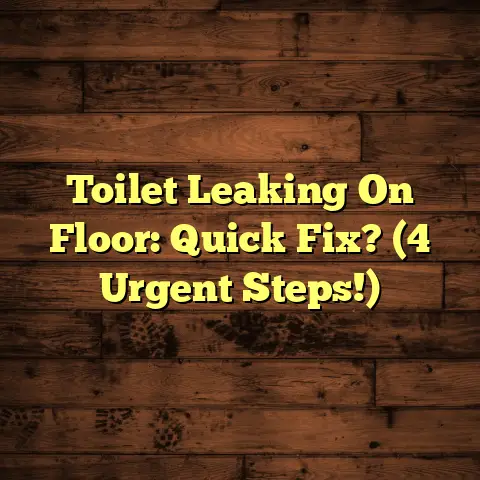Vinyl Plank: Level Floor ESSENTIAL? (3 Subfloor Tips)
(3 Subfloor Tips)
And let me tell you, I’ve seen it all when it comes to flooring installations. One thing that consistently separates a stunning vinyl plank floor from a disappointing one? The subfloor.Vinyl plank flooring has exploded in popularity, and it’s easy to see why. It nails the look of real wood or stone, without the hefty price tag or the fuss. Plus, it’s super durable and easy to clean – a real win-win. But here’s a truth bomb: even the prettiest planks will look off if your subfloor isn’t up to snuff.
Think about it: you’re investing in this beautiful, modern floor, envisioning how it’ll transform your space. But imagine walking in after the install and seeing planks that are slightly warped, or gaps that shouldn’t be there, or even worse, feeling the floor flex underfoot. Not exactly the picture you had in mind, right?
That’s where the level subfloor comes in. It’s not just about aesthetics; it’s about the long-term health and performance of your floor. A level subfloor ensures your planks lock together properly, prevent moisture issues, and generally look fantastic for years to come.
So, stick with me as I share my top 3 subfloor tips that’ll help you avoid the common pitfalls and achieve that flawless vinyl plank floor you’ve been dreaming of. Let’s get to it!
Section 1: Understanding the Importance of a Level Subfloor
Let’s dive deeper into why a level subfloor is the unsung hero of any successful vinyl plank project. I know, I know, subfloors aren’t exactly glamorous. But trust me, spending time on this step will pay off big time in the end.
What happens when your subfloor isn’t level? Well, picture this: you’re laying down your beautiful new vinyl planks, but the surface underneath has dips and bumps. What do you think is going to happen?
- Warping and Gaps: The planks won’t sit flush against each other, leading to unsightly gaps and a floor that looks uneven. This is especially noticeable with longer planks.
- Misalignment: The pattern of your floor will be off. That beautiful wood-look grain or stone pattern will look disjointed, ruining the overall aesthetic.
- Flexing and Movement: Uneven support can cause the planks to flex when you walk on them. This not only feels weird but can also damage the locking mechanisms over time.
- Reduced Lifespan: All the issues above contribute to premature wear and tear. Your floor might start showing signs of damage much sooner than it should, meaning you’ll have to replace it sooner.
Here’s a real-world example. I worked on a house a few years back where the homeowner skipped proper subfloor prep to save time and money. The result? Within a year, the vinyl planks started separating, creating gaps that were not only ugly but also a tripping hazard. They ended up having to redo the entire floor, costing them way more in the long run.
According to the Resilient Floor Covering Institute (RFCI), “Subfloor flatness is critical for successful resilient flooring installations.” They recommend a maximum variation of 3/16 inch over a 10-foot span. That might not sound like much, but even small variations can cause problems.
Now, I know what you might be thinking: “Can’t I just use a thicker underlayment to compensate?” While a good underlayment can help, it’s not a magic bullet. It can smooth out minor imperfections, but it won’t fix a seriously uneven subfloor. Plus, using too thick of an underlayment can actually make the problem worse, leading to a spongy feeling underfoot.
So, what’s the takeaway? A level subfloor is the foundation for a beautiful, long-lasting vinyl plank floor. It’s worth the time and effort to get it right. Trust me, your future self (and your wallet) will thank you.
Section 2: Tip #1 – Assessing Your Current Subfloor
Alright, let’s get practical. Before you even think about laying down those gorgeous vinyl planks, you need to get up close and personal with your subfloor. This means a thorough assessment to identify any potential problems.
Tools You’ll Need:
- A Long Level (at least 6 feet): This is your primary tool for checking for levelness.
- A Straight Edge (like a long metal ruler): Useful for identifying smaller dips and bumps.
- A Measuring Tape: For measuring the size of gaps and variations.
- A Pencil or Marker: For marking problem areas.
- A Moisture Meter (optional but recommended): To check for moisture content.
- A Vacuum or Broom: For cleaning the subfloor before you start.
Step-by-Step Assessment:
- Clean the Subfloor: Start by thoroughly cleaning the subfloor. Remove any dust, debris, nails, or staples. You want a clean surface to work with.
- Visual Inspection: Take a good look at the subfloor. Are there any obvious signs of damage, like cracks, holes, or water stains? Are there any loose boards or areas that seem to be sagging? Mark any problem areas you spot.
- Check for Levelness: This is where your level comes in. Place the level on the subfloor in various directions – lengthwise, widthwise, and diagonally. Look for any gaps between the level and the subfloor. If you see a gap, measure its size using your measuring tape. Remember, the RFCI recommends a maximum variation of 3/16 inch over a 10-foot span.
- Use a Straight Edge: For smaller imperfections, use a straight edge. Place the straight edge on the subfloor and look for any gaps underneath. This is especially useful for identifying small dips or bumps.
- Check for Stability: Walk around on the subfloor and see if you feel any movement or flexing. Pay attention to areas where the subfloor meets the walls or where there are seams. If you feel any movement, it could indicate loose boards or a weak subfloor.
- Check for Moisture: Moisture is the enemy of any flooring installation. Use a moisture meter to check the moisture content of the subfloor. The ideal moisture content will vary depending on the type of subfloor, but generally, you want it to be below 12%.
Specific Considerations for Different Subfloor Types:
- Concrete Subfloors:
- Look for cracks, especially hairline cracks.
- Check for signs of moisture, like efflorescence (a white, powdery substance).
- Use a concrete leveler to fill in any low spots.
- Plywood Subfloors:
- Check for delamination (where the layers of plywood are separating).
- Look for water damage or signs of mold.
- Make sure the plywood is properly fastened to the joists.
- Replace any damaged or weak plywood.
Document Your Findings:
As you assess your subfloor, take notes and photos of any problem areas you find. This will help you develop a plan for repairing and preparing the subfloor.
Example:
Let’s say you’re assessing a plywood subfloor and you find a section where the plywood is delaminating and there’s a noticeable dip. You would:
- Mark the area with a pencil.
- Measure the size of the dip using your measuring tape and straight edge.
- Take a photo of the delamination and the dip.
- Note in your records that this section of plywood needs to be replaced.
By taking the time to thoroughly assess your subfloor, you’ll be able to identify any potential problems and develop a plan for addressing them. This will set you up for a successful vinyl plank installation and a beautiful, long-lasting floor.
Section 3: Tip #2 – Preparing Your Subfloor
Okay, you’ve assessed your subfloor and you’ve got a list of issues to tackle. Now it’s time to roll up your sleeves and get to work! Proper subfloor preparation is essential for ensuring a smooth, level, and long-lasting vinyl plank floor.
Tools and Materials You’ll Need:
- Patching Compound or Self-Leveling Compound: For filling in holes, cracks, and low spots.
- Sanding Block or Floor Sander: For smoothing out high spots.
- Primer: To improve adhesion of the patching compound.
- Wood Screws: For securing loose boards.
- Circular Saw or Reciprocating Saw: For replacing damaged plywood.
- Moisture Barrier (if necessary): To prevent moisture from rising through the subfloor.
- Vacuum or Broom: For cleaning up dust and debris.
Step-by-Step Preparation:
-
Address Moisture Issues: Before you do anything else, you need to address any moisture problems. If you found high moisture readings during your assessment, you’ll need to identify the source of the moisture and fix it. This could involve repairing leaks, improving ventilation, or installing a vapor barrier.
-
Repair Cracks and Holes: Use a patching compound or self-leveling compound to fill in any cracks, holes, or low spots in the subfloor.
- For small cracks and holes: Apply the patching compound with a putty knife, making sure to fill the entire area. Smooth it out and let it dry completely before sanding.
- For larger low spots: Use a self-leveling compound. Follow the manufacturer’s instructions carefully, as these compounds can be tricky to work with. You may need to build up the compound in layers to achieve a level surface.
-
Smooth Out High Spots: Use a sanding block or floor sander to smooth out any high spots in the subfloor.
- For small high spots: A sanding block will usually do the trick.
- For larger high spots: A floor sander will be more efficient. Be careful not to sand too much, as you don’t want to create a low spot.
-
Secure Loose Boards: If you found any loose boards during your assessment, secure them with wood screws. Make sure the screws are long enough to penetrate into the joists below.
-
Replace Damaged Plywood: If you found any damaged or delaminated plywood, it’s best to replace it.
- Use a circular saw or reciprocating saw to cut out the damaged section of plywood.
- Cut a new piece of plywood to the same size and shape.
- Secure the new plywood to the joists with wood screws.
-
Clean the Subfloor Again: Once you’ve finished repairing and patching the subfloor, it’s time to clean it again. Vacuum or sweep up any dust or debris. You want a clean, smooth surface for your vinyl planks.
-
Apply Primer (Optional): Some patching compounds recommend applying a primer before installing the vinyl planks. Check the manufacturer’s instructions for your specific patching compound. Primer helps to improve adhesion and prevent the patching compound from drying out too quickly.
Specific Considerations for Different Subfloor Types:
- Concrete Subfloors:
- Use a concrete grinder to smooth out any rough spots.
- Apply a concrete sealer to prevent moisture from rising through the subfloor.
- Plywood Subfloors:
- Make sure the plywood is properly fastened to the joists.
- Consider adding a layer of underlayment to create a smoother surface.
Example:
Let’s say you’re preparing a plywood subfloor and you find a large crack. You would:
- Clean the crack thoroughly.
- Apply a primer to the crack.
- Fill the crack with a patching compound, making sure to pack it in tightly.
- Smooth out the patching compound with a putty knife.
- Let the patching compound dry completely.
- Sand the patching compound smooth.
By taking the time to properly prepare your subfloor, you’ll be setting yourself up for a successful vinyl plank installation and a beautiful, long-lasting floor. Don’t skip this step!
Section 4: Tip #3 – Choosing the Right Underlayment
You’ve got a level, clean, and prepped subfloor. Awesome! Now, let’s talk about underlayment. Think of underlayment as the final touch that elevates your vinyl plank floor from good to amazing.
What is Underlayment?
Underlayment is a thin layer of material that you install between the subfloor and the vinyl planks. It provides a number of benefits, including:
- Smoothing Out Minor Imperfections: Even with careful subfloor preparation, there may still be some minor imperfections. Underlayment can help to smooth these out, creating a more even surface for your vinyl planks.
- Sound Insulation: Underlayment can help to reduce noise transmission, making your floor quieter to walk on.
- Moisture Protection: Some underlayments have a built-in moisture barrier, which can help to protect your vinyl planks from moisture damage.
- Added Comfort: Underlayment can add a bit of cushioning underfoot, making your floor more comfortable to walk on.
Types of Underlayment:
There are many different types of underlayment available, each with its own pros and cons. Here are a few of the most common types:
- Foam Underlayment: This is a popular choice because it’s affordable, easy to install, and provides good sound insulation.
- Cork Underlayment: Cork is a natural material that’s known for its excellent sound insulation and moisture resistance.
- Rubber Underlayment: Rubber underlayment is a durable and resilient option that’s ideal for high-traffic areas.
- Combination Underlayment: Some underlayments combine different materials to provide a range of benefits. For example, you might find an underlayment that combines foam and a moisture barrier.
Choosing the Right Underlayment:
The best type of underlayment for your project will depend on several factors, including:
- Your Subfloor: If you have a concrete subfloor, you’ll want to choose an underlayment with a built-in moisture barrier. If you have a plywood subfloor, you can choose from a wider range of options.
- Your Budget: Underlayment prices can vary widely, so it’s important to choose an option that fits your budget.
- Your Noise Concerns: If you’re concerned about noise transmission, choose an underlayment with good sound insulation properties.
- Your Comfort Preferences: If you want a more comfortable floor, choose an underlayment with good cushioning.
- Vinyl Plank Manufacturer Recommendations: Always check the vinyl plank manufacturer’s recommendations for underlayment. Some manufacturers require specific types of underlayment to maintain the warranty.
Installation Tips:
- Follow the Manufacturer’s Instructions: Always follow the manufacturer’s instructions for installing the underlayment.
- Stagger the Seams: Stagger the seams of the underlayment to prevent them from lining up with the seams of the vinyl planks.
- Tape the Seams: Tape the seams of the underlayment with seam tape to prevent moisture from seeping through.
- Ensure a Smooth Surface: Make sure the underlayment is smooth and free of wrinkles or bubbles before installing the vinyl planks.
Example:
Let’s say you’re installing vinyl planks in a basement with a concrete subfloor. You would:
- Choose an underlayment with a built-in moisture barrier to protect the vinyl planks from moisture.
- Follow the manufacturer’s instructions for installing the underlayment.
- Stagger the seams of the underlayment.
- Tape the seams of the underlayment with seam tape.
- Ensure the underlayment is smooth and free of wrinkles or bubbles before installing the vinyl planks.
By choosing the right underlayment and installing it properly, you’ll be adding the finishing touch to your vinyl plank floor and ensuring that it looks and performs its best for years to come.
Conclusion
So there you have it – my top 3 subfloor tips for a flawless vinyl plank installation! We’ve covered a lot, from understanding why a level subfloor is crucial, to assessing your current subfloor, to preparing it properly, and finally, choosing the right underlayment.
Remember, a level subfloor isn’t just about aesthetics; it’s about the long-term health and performance of your floor. By taking the time to do it right, you’ll avoid common problems like warping, gaps, and misalignment, and you’ll ensure that your vinyl planks look beautiful for years to come.
Think of it this way: your subfloor is the foundation of your entire flooring project. If the foundation is weak or uneven, the rest of the project will suffer. But if you take the time to build a solid foundation, you’ll be rewarded with a stunning, long-lasting floor that you’ll be proud of for years to come.
I know that subfloor preparation can seem like a daunting task, but it doesn’t have to be. By following these tips and taking your time, you can achieve a professional-looking result that will transform your space.
And remember, if you’re not comfortable tackling this project yourself, don’t hesitate to hire a professional flooring contractor. They have the experience and expertise to ensure that your subfloor is properly prepared and that your vinyl planks are installed correctly.
So, go ahead and get started on your vinyl plank flooring project! With a little planning and effort, you can create a beautiful and durable floor that you’ll love for years to come.
Good luck, and happy flooring!





